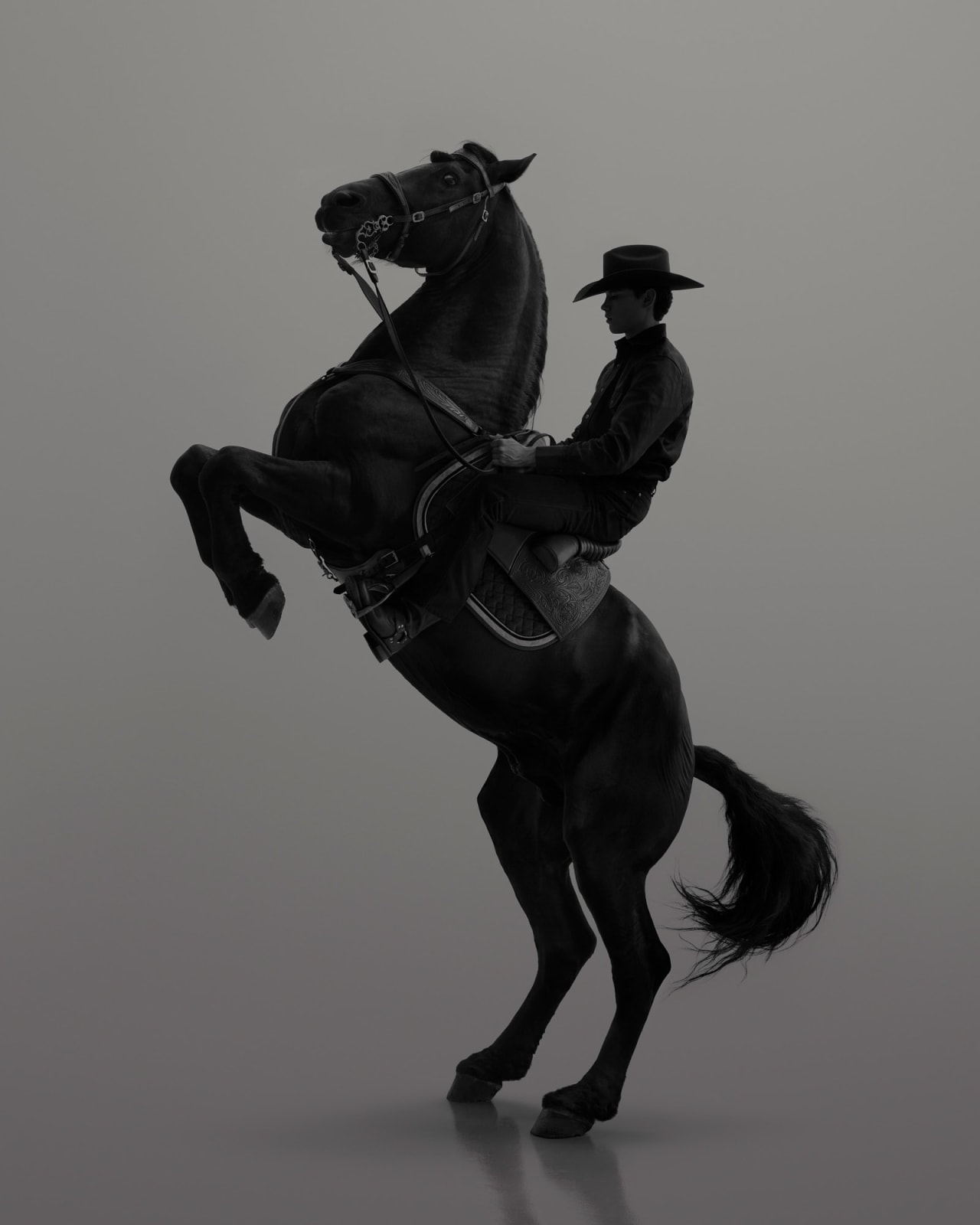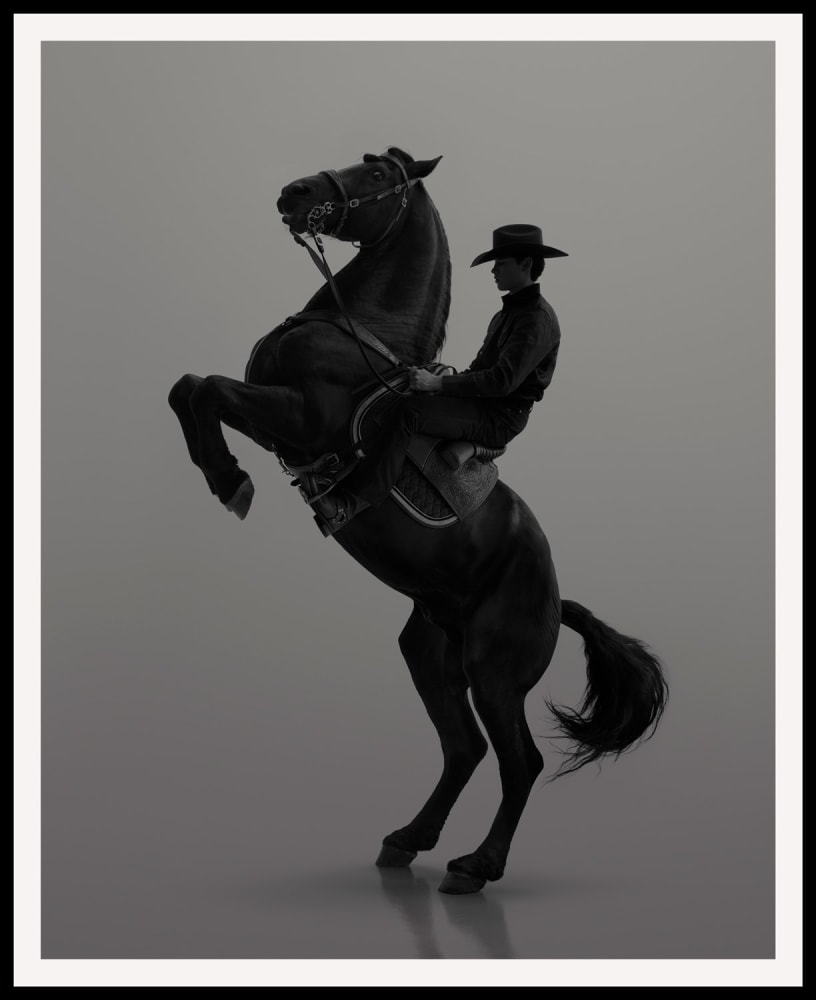Dean West Australian, b. 1983
Cade Silhouette #2, 2022
Series: American West
Archival pigment print
184.2 x 147.3 cm
72 1/2 x 58 in
72 1/2 x 58 in
Edition of 3 plus 2 artist's proofs
152.4 x 121.9 cm
60 x 48 in
60 x 48 in
Edition of 6 plus 2 artist's proofs
120.7 x 96.5 cm
47 1/2 x 38 in
47 1/2 x 38 in
Edition of 9 plus 2 artist's proofs
Further images
'Cowboys need nothin’ more than a hat, horse, and the will to ride.' From Buffalo Bill to Billy the Kid, cowboys have played an iconic role in American history. The...
"Cowboys need nothin’ more than a hat, horse, and the will to ride."
From Buffalo Bill to Billy the Kid, cowboys have played an iconic role in American history. The thrill of the Wild West has become a major trait of pop culture, leading to numerous TV shows and movies. Symbol of an ideal masculinity represented by American icons such as John Wayne, Clint Eastwood, the Marlboro Man, or the Lone Ranger, the image of cowboys has evolved in parallel with society. Since the 00s, Hollywood has allowed a more nuanced sexual orientation with movies such as Brokeback Mountain (2005). In this way, the Hollywood Cowboy as a generic icon has redefined modern conceptions of heterosexuality and masculinity.
With this photograph, Dean West digs further into the cowboy's theme with this full-length studio portrait of Cade and a black stallion named Veleno. The deliberate sobriety of the background drives the viewer straight to the essence of the subject while the choice of black and white highlights the classic silhouette of the prancing horse, the cowboy and his hat.
_____________
"Les cowboys n'ont besoin de rien d'autre que d'un chapeau, un cheval, et la volonté de monter dessus."
De Buffalo Bill à Billy The Kid, les cowboys ont toujours joué un role incontournable dans l'histoire américaine. L'attrait du "Wild West" est devenu un trait majeur de la culture populaire, à l'origine de nombreux films ou émissions télévisées. Symbole d'un idéal masculin incarné dans les icônes américaines tels que John Wayne, Clint Eastwood, le cowboy Marlboro, ou le Justicier solitaire, l'image du cowboy a évolué avec la société. Depuis les années 2000, l'industrie cinématographique hollywoodienne a permis l'instauration d'une version plus nuancée de l'orientation sexuelle de cette figure classique avec des productions telles que Brokeback Mountain (2005). La figure du cowboy a de fait redéfini les clichés de masculinité et d'hétérosexualité au sein de la société américaine.
Cher à Dean West, poursuit son travail sur le thème du cowboy avec ce portrait studio en pied de Cade et un étalon nommé Veleno. La sobriété délibérée du fond oriente le regardeur directement l'essence même du sujet alors que le choix du noir et blanc met en valeur la silhouette classique du cheval cabré, du cavalier et de son chapeau.
From Buffalo Bill to Billy the Kid, cowboys have played an iconic role in American history. The thrill of the Wild West has become a major trait of pop culture, leading to numerous TV shows and movies. Symbol of an ideal masculinity represented by American icons such as John Wayne, Clint Eastwood, the Marlboro Man, or the Lone Ranger, the image of cowboys has evolved in parallel with society. Since the 00s, Hollywood has allowed a more nuanced sexual orientation with movies such as Brokeback Mountain (2005). In this way, the Hollywood Cowboy as a generic icon has redefined modern conceptions of heterosexuality and masculinity.
With this photograph, Dean West digs further into the cowboy's theme with this full-length studio portrait of Cade and a black stallion named Veleno. The deliberate sobriety of the background drives the viewer straight to the essence of the subject while the choice of black and white highlights the classic silhouette of the prancing horse, the cowboy and his hat.
_____________
"Les cowboys n'ont besoin de rien d'autre que d'un chapeau, un cheval, et la volonté de monter dessus."
De Buffalo Bill à Billy The Kid, les cowboys ont toujours joué un role incontournable dans l'histoire américaine. L'attrait du "Wild West" est devenu un trait majeur de la culture populaire, à l'origine de nombreux films ou émissions télévisées. Symbole d'un idéal masculin incarné dans les icônes américaines tels que John Wayne, Clint Eastwood, le cowboy Marlboro, ou le Justicier solitaire, l'image du cowboy a évolué avec la société. Depuis les années 2000, l'industrie cinématographique hollywoodienne a permis l'instauration d'une version plus nuancée de l'orientation sexuelle de cette figure classique avec des productions telles que Brokeback Mountain (2005). La figure du cowboy a de fait redéfini les clichés de masculinité et d'hétérosexualité au sein de la société américaine.
Cher à Dean West, poursuit son travail sur le thème du cowboy avec ce portrait studio en pied de Cade et un étalon nommé Veleno. La sobriété délibérée du fond oriente le regardeur directement l'essence même du sujet alors que le choix du noir et blanc met en valeur la silhouette classique du cheval cabré, du cavalier et de son chapeau.












